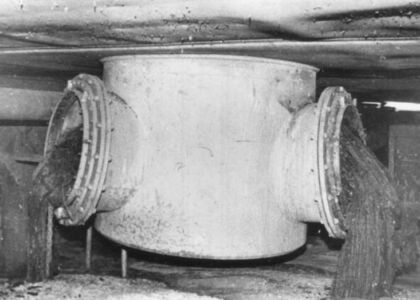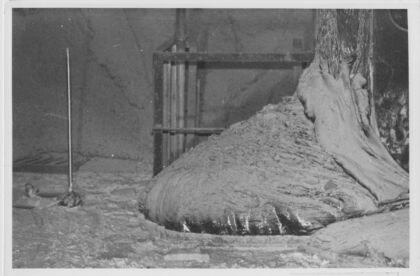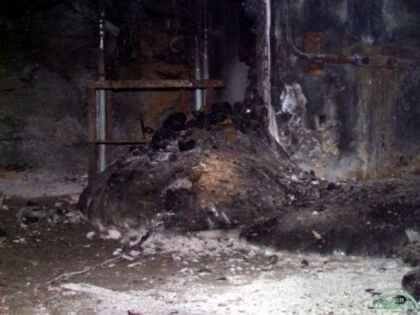Maybe you didn’t hear about it and you are wondering what an elephant’s foot is doing in the Chernobyl Nuclear Power Plant. Well, obviously, it’s not an elephant’s foot, but a melted core of destroyed Reactor #4 which resembles its shape.
Much can be said about the photo below. The words “haunting”, “eerie” and “strange” certainly come to mind at first glance. Of course, to anybody unaware of what ‘Corium’ (is, this does indeed appear to be some melted iron or something like that. In fact, it is the most radioactive place in the whole world.
Why? As Wikipedia is saying, Corium is (also called fuel containing material (FCM) or lava-like fuel containing material (LFCM)) is the lava-like mixture of fissile material created in a nuclear reactor’s core during a nuclear meltdown. It consists of nuclear fuel, fission products, control rods, structural materials from the affected parts of the reactor, products of their chemical reaction with air, water and steam, and, in the event that the reactor vessel is breached, molten concrete from the floor of the reactor room.
The most dangerous discovery
 Corium flowing like lava through the reactor. The valve was made for steam to move through.
Corium flowing like lava through the reactor. The valve was made for steam to move through. Photo: PNNL library
Eight months after the April 1986 nuclear accident at the Chernobyl NPP, a team of scientists made one of their first and most memorable discoveries – Elephant’s Foot.
They entered a corridor beneath the damaged No. 4 reactor and discovered a startling phenomenon: a massive globular, stalagmite-like formation of some mysterious substance – a black lava that had flowed from the reactor core, as if it had been some sort of human-made volcano. One of the hardened masses was particularly startling, and the crew nicknamed it the Elephant’s Foot because it resembled the foot of the massive mammal.
Sensors showed workers that the lava formation was so radioactive that it would take a person five minutes to receive a lethal amount of radiation, as detailed by Kyle Hill in a 2013 article for the science journal Nautilus.

Liquidators near corium at the destroyed part of the Reactor 4, Chernobyl NPP.
Photo: Unknown
From a safe distance, liquidators rigged up a crude wheeled camera contraption and pushed it towards the Elephant’s Foot. After careful examination, they determined that it wasn’t all nuclear fuel. In fact, the mass was comprised of only a small percentage of fuel; the rest was melted concrete, sand, and core shielding that all melted and flowed together. The material was dubbed “corium,” after the part of the reactor that spawned it. Over time, the Elephant’s Foot decomposed. It puffed dust and its surface cracked.
How was Elephant’s Foot formed?
During the nuclear explosion of Chernobyl, radioactive plumes rose high above the plant, poisoning the area. The rods liquefied below, melting through the reactor vessel to form Corium. After the nuclear fires were finally controlled, workers scrambled to contain the invisible dangers of the Chernobyl core.
On April 26, 1986, during a routine test reactor 4 at the Chernobyl NPP experienced a power surge that triggered an emergency shutdown. It did not work. Workers at the power plant attempted to manage the surge in power and the alarming increase in the core’s temperature caused an even larger power surge.
Control rods that are served to manage core temperature were inserted too late. Their insertion into the hot core caused the rods themselves to crack and fracture, locking them in place. Heat and power output continued to rise until the water that was used to cool the entire reactor vaporized, generating massive amounts of pressure.
 So as you can see, these things are an actually non-living monster, which can kill you within minutes if you’ll be standing next to it for a few minutes. Even in this photo, which was taken 10 years after the Chernobyl incident, the radiation would have been extremely dangerous.
So as you can see, these things are an actually non-living monster, which can kill you within minutes if you’ll be standing next to it for a few minutes. Even in this photo, which was taken 10 years after the Chernobyl incident, the radiation would have been extremely dangerous.Photo: Unknown
There were two explosions: the first explosion from the steam inside the reactor was enough to send the 4-million-pound lid of the reactor assembly through the roof of the building. Now catastrophically damaged, the remaining cooling water from broken channels seeped into the reactor as well, turning directly into steam as it touched the increasingly hot nuclear fuel rods. A second explosion, even more massive followed shortly after the first, belching broken core material into the air, spreading fire and radioactive detritus.
With a glowing heart no longer shielded by tons of steel and concrete, the core could no longer be cooled. It began to melt down – the radioactive materials used as fuel get hotter, due to their unstinting emission of high-energy particles, until they literally melt, turning into something like lava.
At Chernobyl NPP, the loss of coolant caused a meltdown of the fuel, some of which was scattered into the atmosphere. Much of it flowed into the bottom of the reactor vessel and eventually melted through it. Oozing through pipes and eating through concrete, the radioactive lava flow from reactor Number 4 eventually cooled enough to solidfy. The result was a collection of stalactites and stalagmites, steam valves clogged with hardened lava, and the large black mass that would later be dubbed the Elephant’s Foot.
After six months of investigation, researchers discovered the Elephant’s Foot. In this incident, the Corium resembles the shape of an elephant’s foot, hence the name. Today, it still radiates heat and death, and is therefore still very dangerous. Fortunately, it is sealed under the New Safe Confinement, so visiting the Chernobyl Power Plant and working near the new sarcophagus is safe. From this huge, insane lump of Corium we truly see some of the devastating effects of radioactive material at its prime.
Was the elephant foot shot with an AK-47 ?
 Elephant Foot – an accumulation of fuel-containing masses.
Elephant Foot – an accumulation of fuel-containing masses. Photo: Chernobyl NPP
The formation, which is named the Elephant’s Foot, stood half as tall as a man and weighed as much as 2 tonnes. Reports from Chernobyl estimated that this formation was practically off the charts, putting out nearly 10,000 roentgens per hour: 5 minutes in its presence was enough to guarantee an agonizing death. It takes about 1/10th of that to kill a person. In one hour, the Elephant’s Foot would expose you to the radiation of over four and a half million chest x-rays. That dose is almost 1,000 times stronger than exposures that have been clearly linked to increased cancer risk.
Because of the way radiation damages human cells—by knocking atoms and molecules out of place—death by radiation is a relatively slow one. Up to a point, treatment helps. But high doses, like the kind delivered by close contact with the Elephant’s Foot, can’t be tolerated.
Nonetheless, orders came down from the government commission for photographs and a full analysis.
Unable to find the fuel from the reactor, the scientists had also found no sign so far of the more than 16 thousand tonnes of materials dropped into the reactor by General Antoshkin’s heroic helicopter crews and therefore hoped that the Elephant’s Foot might contain some lead intended to cool the core. But it did not readily surrender samples for testing.
The substance proved too hard for a drill mounted on a motorized trolley, and a soldier who volunteered to attack it with an axe left the room empty-handed—and so overexposed he had to be evacuated immediately from Chernobyl. Finally, a police marksman arrived and shot a fragment with Kalashnikov AK-47 of the surface away with a rifle.
300 seconds
 Photo taken in 1990, 4 years after the incident. This slide was given to a doctor, Bill Zoller at the University of Washington Department of Chemistry.
Photo taken in 1990, 4 years after the incident. This slide was given to a doctor, Bill Zoller at the University of Washington Department of Chemistry.300 seconds will produce a relatively quick death, which is better than many alternatives. After just 30 seconds of exposure, dizziness and fatigue will find you a week later. Two minutes of exposure and your cells will soon begin to hemorrhage; four minutes: vomiting, diarrhea, and fever. 300 seconds and you have two days to live.
In the days and weeks after the Chernobyl disaster in late April 1986, simply being in the same room with the Elephant’s Foot – would have killed you within 5 minutes.
Even a decade later, when this image (below) was taken, the radiation probably caused the film to develop strangely, creating the photo’s grainy quality. At first glance, it is difficult to understand what is happening in the photograph. A giant mushroom seemed to grow from under the floor, and ghostly people in helmets seemed to be working next to it.
 Artur Korneyev, Deputy Director of Shelter Object, viewing the elephant’s foot lava flow at Chernobyl, 1996.
Artur Korneyev, Deputy Director of Shelter Object, viewing the elephant’s foot lava flow at Chernobyl, 1996. Photo: US Department of Energy
The man in this photo, Artur Korneyev, the worker is miraculously still alive. This man entered this room more times than anybody else, thus he would have been more exposed to the huge amounts of radiation than anybody else in history.
Interesting fact: The photo itself was most likely a ‘selfie’, judging by the fact that all other photos were taken by Artur and many others may not have been daring enough to go inside. It really is remarkable that he went right up to the most toxic substance there is, numerous times by himself!
Born of human error, continually generating copious heat, the Elephant’s Foot is still melting into the base of the Chernobyl Nuclear Power Plant. If it hits ground water, it could trigger another catastrophic explosion or leach radioactive material into the water nearby residents drink.
 The Elephant’s Foot at Chernobyl. The image appears blurry because of the high radiation.
The Elephant’s Foot at Chernobyl. The image appears blurry because of the high radiation. Photo: UNIVERSAL HISTORY ARCHIVE
10 years later, the U.S. The Department of Energy’s International Nuclear Safety Project collected hundreds of pictures of Chernobyl, obtained several images of the Elephant’s Foot, which was estimated to weigh 2 tons.
Long after flowing from the core, this unique piece of waste continues to be a testament to the potential dangers of nuclear power. The Elephant’s Foot will be there for centuries, sitting in the dark basement of a concrete and steel Sarcophagus, a symbol of one of humankind’s most powerful tools gone awry.
Chernobylite
A team from the University of Sheffield has used depleted uranium to develop low-activity materials that accurately mimic the microstructure and mineralogy of real-LFCMs (lava-like fuel-containing materials).
 Corium at the destroyed part of the Chernobyl NPP. Between 2007-2010.
Corium at the destroyed part of the Chernobyl NPP. Between 2007-2010.Photo: A.Kupnyi
The researchers conducted the first successful synthesis of a high uranium–zircon silicate, via crystallization from a glass melt. Subsequently, the alloy of uranium, zirconium and silicon received an unofficial name – “Chernobylite”. This is how it is now accepted by geologists to call the lava-like material and its formations, which arose as a result of the melting of the core of the 4th reactor of the Chernobyl Nuclear Power Plant. This material became a kind of discovery in the field of geology and mineralogy.
“Chernobylite” is a crystalline form of zirconium orthosilicate with a huge content of solid uranium. In simple words, it is an alloy of nuclear fuel components with many other compounds, it’s not possible to find such a mineral in nature just like that. It’s a product exclusively of the creation of “human hands”, no matter how paradoxical it may sound. Its formation is possible only under conditions leading to a nuclear explosion. The structure of this mineral is quite unusual. These are bipyramidal crystals of various sizes, there are specimens from both 5 and up to 500 microns.
 The lava-like fuel-containing material at the Chernobyl NPP. Between 2007-2010.
The lava-like fuel-containing material at the Chernobyl NPP. Between 2007-2010.Photo: A.Kupnyi
Today it is still difficult to imagine what can be done with such material? Could it be useful, say, in some industrial branch? Only one thing can be asserted with probability – modern science still knows very little about such minerals. In particular, no one will undertake to suggest what other substances or compounds can be obtained with the help of a nuclear explosion.
It is not known how many more years will pass when scientific discoveries in this area will become peaceful and will have nothing to do with the consequences of terrible man-made disasters.
Interesting fact: Polish video game developer “The Farm 51” has developed the video game “Chernobylite”. The game is set in the Chernobyl Exclusion Zone, where the player’s objective is to explore, as Ukrainian physicist Igor Khymynuk, and find his fiancée in the radioactive wasteland.
Despite being only a small part of the roughly 100 tons of lava created during the meltdown, the Elephant’s Foot has become symbolic of the horrifying legacy of Chernobyl, largely due to its intense radioactivity.
Although it is extremely dangerous and due to security, it is impossible to see the Elephant’s foot with your own eyes, it is possible to get inside the Chernobyl power plant. During your 3-hour excursion, you will see the powerplant from inside including the “golden corridor”, control room of reactor #3 (which looks exactly like the damaged one in the reactor. #4), evacuation center and much more.
Oh, and for more courageous adventurers we have a time-limited opportunity to visit the Control Room 4. Well, that’s a truly interesting excursion! If you are interested in this tour, contact us via e-mail on info@chernobylx.com



 ChernobylX
ChernobylX
 ChernobylX
ChernobylX